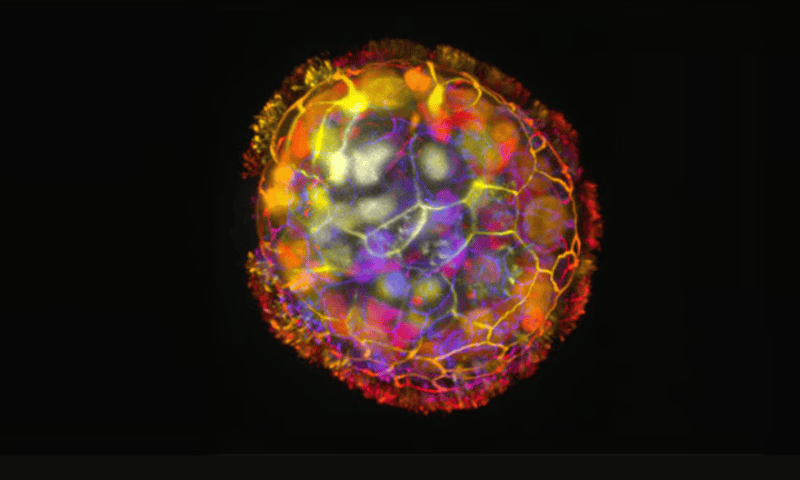Science fiction has come to life once again: Researchers have developed tiny biological robots, or biobots, that can heal brain cells, at least in a petri dish.
In a study published Nov. 30 in Advanced Science, a research team led by scientists from Tufts University and the Wyss Institute at Harvard University described how they used unaltered human tracheal cells to create self-assembling multicellular robots that range in size from the width of a hair to the point of a pencil. Dubbed Anthrobots, the robots were able to stimulate a layer of live, wounded human neurons to regrow. The scientists hope to eventually use them as tools in regenerative medicine as well as to clear arterial plaque and recognize bacteria and cancer cells.
“It is fascinating and completely unexpected that normal patient tracheal cells, without modifying their DNA, can move on their own and encourage neuron growth across a region of damage,” study co-lead Michael Levin, Ph.D., said in a press release. “We’re now looking at how the healing mechanism works, and asking what else these constructs can do.”
The development expands on previous work done by Levin’s lab with Xenobots. Like the Anthrobots, those biobots were also multicellular and could swim on their own without external stimulation. But while the Xenobots could heal themselves from injury—among many other things, including record information—they were not designed to heal other cells. They were also sculpted individually from frogs’ embryonic stem cells, rather than grown organically from tracheal cells taken from adult donors like the Anthrobots.
At the time, it wasn’t clear if the Xenobots’ motility might extend to biobots grown from mammalian cells, the researchers explained in their paper. “Thus, we sought to address whether the capacity of genetically unaltered cells to generate a self-propelled, multicellular living structure in this way is unique to amphibian embryonic cells,” they wrote, as well as whether the cells could be “coaxed to self-construct” from an initial parent cell rather than being molded one by one.
The researchers chose human tracheal cells to build their new biobots because the cells already possessed some key anatomical characteristics, as other labs’ research on airway tissue organoids had shown. The cells of the inner trachea are covered in hair-like projections called cilia, which move together to help push out mucus. In their new study, the Levin lab grew similar organoids under conditions that made the cilia grow outwards, allowing them to act like “oars” that could move them around.
The researchers found that the Anthrobots organically developed into several subtypes of structure and movement patterns. Some were stationary “wigglers”; others moved linearly or in small circles. All of them lived for 45 to 60 days in a petri dish, then degraded.
After seeing that the Anthrobots could move across tissue, the researchers tested them for their regenerative potential. They grew a 2D layer of human neurons and scratched it with a metal rod, creating a wound. Next, inspired by “swarm intelligence” seen in nature—the ability of collectives to accomplish more than an individual—they put a group of the Anthrobots into a smaller dish, driving them to form a cluster the scientists dubbed a “superbot”. The superbot was composed mainly of “wigglers” and “circlers”, with the logic that these would be less likely than those that moved linearly to migrate away from the site of repair.
The researchers placed superbots around the wound so they could bridge its two sides, “akin to a mechanical stitch,” they wrote in the paper. Within 72 hours, they saw that the native neuronal tissue was regrowing to close the gap at the sites where superbots had been placed. Additional analysis showed that the tissue was thicker at the gap closure sites as it was outside the wound, while tissue in other parts of the wound that didn’t have superbot coverage were much thinner.
To be sure that the healing couldn’t be explained by simple mechanical contact, the researchers created another neuron scratch model and placed a piece of gel on top of it for four days. The wound didn’t change, suggesting that the biobots were indeed responsible for the repair.
The findings set the stage for a research program to further investigate how the Anthrobots could be used therapeutically, the scientists wrote in their paper. They could eventually be customized by using other ciliated cell types to create them, or to induce ciliation in cells that don’t have cilia naturally. In theory, they could be used for functions beyond regenerative medicine, too, such as clearing plaque from arteries in the heart. Other types of biobots are already being tested for their potential use in treating cancer, like E. coli-based “microbots” used to ferry drugs to tumor cells.

